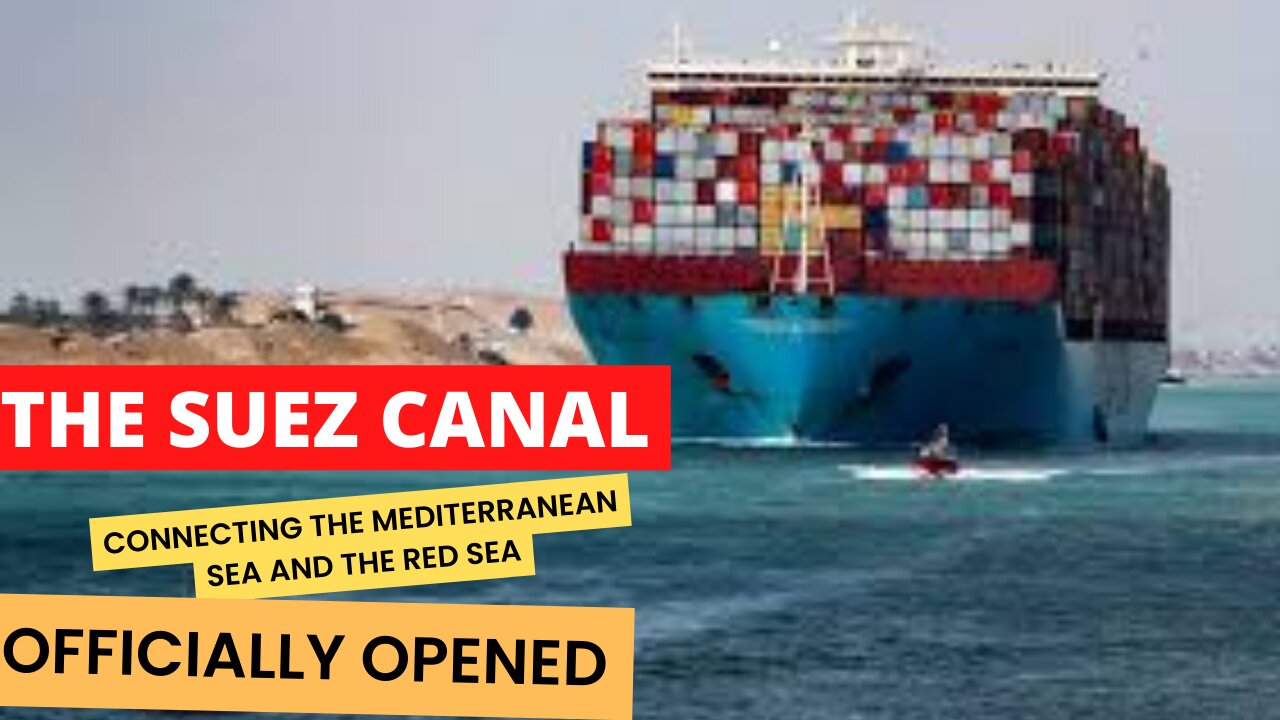Premium Only Content

The Suez Canal Connecting the Mediterranean Sea and the Red Sea is Officially Opened
The Suez Canal Connecting the Mediterranean Sea and the Red Sea is Officially Opened
The construction of canals or canals is important to expedite the pace of transportation, support trade, and even business. This canal is able to speed up travel time so as to boost the economy.
On November 17, 1869, the canal located in the city of Port Said or the Suez Canal, was finally officially opened and operational. The inauguration was attended by the Queen of France, Eugenie, wife of Napoleon III.
The opening of the Suz Canal connecting the Red Sea and the Mediterranean so that it can shorten the shipping time that previously had to go around the Cape of Good Hope, South Africa.
When Egypt was under the Ptolemaic dynasty (305 BC-30 BC), a canal was made to connect Bitter Lake to the Mediterranean Sea. Also made a canal that connects Lake Timsah to the north until it reaches the Nile River.
However, the canal was not properly maintained and was destroyed for reasons of military considerations.
There was a plan in the 15th century when Europeans envisioned a sea route that would allow merchant ships to sail from the Mediterranean Sea to the Indian Ocean via the Red Sea.
The obstacle that occurred at that time was that all merchant ships from the Mediterranean Sea had to go around the Cape of Good Hope in South Africa which took a long time.
Finally, the rulers of France under the command of Napoleon Bonaparte came up with a plan to rebuild the canal. Architect Ferdinand de Lesseps was authorized to prepare the construction of the building.
An agreement with the Egyptian Authorities began in 1854 to make this canal for mutual benefit as far as 160 kilometers.
An international team of experts drew up construction plans and in 1856 the Suez Canal Company was formed.
Construction began in April 1859 with the first excavation being carried out by forced labourers. Workers from Europe started arriving with steam-powered dredgers and shovels.
Cholera outbreaks and labor disputes put the construction of the canal behind schedule. The construction is four years behind schedule all planned.
The opening of the Suez Canal was delayed several years due to obstacles. But in the end, this canal was still opened for the common good.
When opened the Suez Canal only has a depth of 7.6 meters with a width of 72 meters at the bottom and 60-90 meters at the top.
As a result, more than 500 vessels operated using the services of this canal in the first year.
In 1875, Britain became the largest shareholder in the Suez Canal Company when it bought shares of the new governor in Egypt, then under the rule of the Ottoman Empire.
A year later, the Suez Canal underwent several repairs and became one of the busiest shipping lines in the world. Many ships pass through this route to speed up travel time.
Seven years later, the British invaded Egypt and occupied the country until the 1936 treaty that made Egypt an independent nation. However, the Suez Canal remained under British control.
After World War II ended, the Government of Egypt urged British troops to withdraw from the Suez Canal area. This situation was followed by the decision of Egyptian President Gamal Abdel Nasser to nationalize the canal in 1956.
The purpose of the nationalization was to get income from the Suez Canal, so that it could be used to build a gigantic dam on the Nile River.
As a result of this nationalization, in October 1956 Israeli troops carried out an invasion followed by the arrival of British and French troops in early November to control the canal zone.
Under the hands of the United Nations, Britain and France finally withdrew their troops in December 1956 and Israeli troops withdrew in March 1957.
At that time, the Government of Egypt fully controlled the Suez Canal and reopened it for international shipping.
Whole ownership gives Egypt more income. In 1966, the Suez Canal passed more than 21,000 ships.
Approximately 10,000 tankers pass through it, with an average of 56 ships passing each day. As a result, Egypt's income was more than 200 million US dollars at that time.
The Suez Canal was closed again when the Six Day War broke out and Israel occupied the Sinai Peninsula. For the next eight years, the Suez Canal, which separated the Sinai from the rest of Egypt, became the front line of war between Israel and Egypt.
On June 5, 1975, the Suez Canal reopened. The reopening followed a second separation deal between Israel and Egypt in which Israel withdrew its troops.
-
 8:11:50
8:11:50
MyronGainesX
1 day ago $64.43 earnedObama Treason, Syrian War, WNBA L, Mehdi vs Rightwingers, Candace v Nick!
160K59 -
 3:14:26
3:14:26
PandaSub2000
1 day agoGame Boy Night 6 | ULTRA BEST AT GAMES (Original Live Version)
31K2 -
 3:12:54
3:12:54
MattMorseTV
11 hours ago $22.47 earned🔴Reacting to the DEBATE.🔴20 BASED vs. 1 WOKE.🔴
101K47 -
 43:10
43:10
The Mel K Show
18 hours agoMel K & Dr. Karlyn Borysenko | It's the Unions!?! Collectively Organizing the Fall of This Nation | 7-20-25
89.7K77 -
 3:00:28
3:00:28
IsaiahLCarter
1 day ago $10.32 earnedWedding Bells and Gnostic Spells || APOSTATE RADIO 024 (with Keri Smith)
61.6K3 -
 12:14:58
12:14:58
Spartan
15 hours agoSpartan - Pro Halo Player for OMiT | Scrims vs C9 then ranked
60.3K6 -
 2:16:19
2:16:19
vivafrei
19 hours agoEp. 273: Russia Hoax CONFIRMED! Will ARRESTS Follow? Trump SUES WSJ! Epstein Docs Release? & MORE!
156K174 -
 4:15:15
4:15:15
EricJohnPizzaArtist
6 days agoAwesome Sauce PIZZA ART LIVE Ep. #55: Wendy Wild!
54.9K2 -
 11:54
11:54
Tundra Tactical
12 hours ago $7.81 earnedIf You Laugh at These Gun Memes, the ATF Gets Your Dog – Tundy Meme Review
68.4K2 -
 4:08:53
4:08:53
Cewpins
8 hours agoSunday Sesh🍃weed💨420🔥!Giveaway !mj
26.5K11